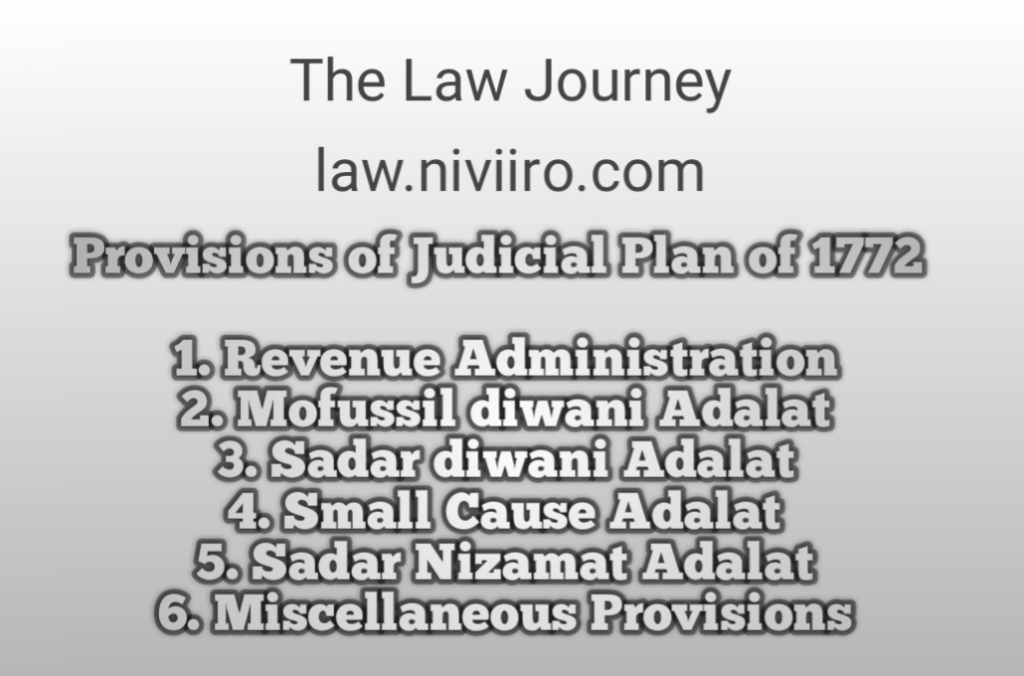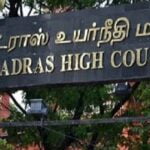Judicial Plan of 1772, Warren Hastings was appointed as the Governor General for the administration of Bengal in 1772.
He also assumed the position of governor of Fort William in 1772. Warren Hastings found that the administration of Bengal was dissatisfied.
At that time the financial position of the company was not good so he felt the urgent need to initiate reforms and as a result he appointed a committee consisting of a governor or four members of the council called ‘circuit committee’. He abolished the dual system introduced by Robert Clive.
Provisions of Judicial Plan of 1772

1. Revenue Administration
The Warren Hastings Judicial Plan of 1772 abolished the revenue courts of Murshidabad and Patna and introduced a supreme authority called the ‘Board of Revenue’ consisting of a governor and all members of the council for revenue collection. The board was to sit twice a week.
2. Mofussil diwani Adalat | Judicial Plan of 1772
The Mofussil diwani Adalat was established in Bengal. An English collector was appointed as a judge in each district.The court could decide civil matters including inheritance, succession marriage, property, contract etc. Appeals from the court went to the Sadar Diwani Adalat if the case value was more than Rs 500. The meeting of the Mofussil diwani Adalat was held twice a week.
3. Sadar diwani Adalat | Judicial Plan of 1772
The Sadar Diwani Adalat consisted of a governor and members of the council. It had high jurisdiction in Calcutta. Appeals from the Mofussil diwani Adalat in cases above Rs 500 were heard in the Sadar Diwani Adalat. The first meeting of the court was held on 17 March 1773. A fee of 5% was fixed on each appeal.
4. Small Cause Adalat | Judicial Plan of 1772
It could decide small cases up to 10 rupees which was finally decided by the head farmer of the praganah.
5. Sadar Nizamat Adalat | Judicial Plan of 1772
The Sadar Nizamat court consisted of an Indian judge known as the Daroga-i-Adalat, consisting of a chief Qazi, a chief mufti and three maulvies. These persons were earlier appointed by the Nawab on the advice of the Governor. This court also heard the appeals of the Mofussil Criminal Court.
6. Miscellaneous Provisions | Judicial Plan of 1772
Provisions were made to promote pure and fair justice. All cases were to be heard in open court. All courts were to maintain proper registers and records of all cases. Any case older than 12 years was not actionable.
Defects of the plan of 1772
1. The major drawback of the Act was that many powers were vested in a person known as the Collector as he was an administrator of revenue, collector, civil service and was a magistrate in his district.
2. As the judges of the court were Englishmen, he had no knowledge of the personal law of Hindus and Muslims.
3. Rupees 10 and smaller for all other cases the number of courts was less. There was only one court in the district.
4. There was no separation between revenue collection and civil administration.
5. The collector paid more attention to revenue collection then to civil administration.
Related Post
Important Questions
Explain Revenue Administration under the Judicial act 1772 ?
The Warren Hastings Judicial Plan of 1772 abolished the revenue courts of Murshidabad and Patna and introduced a supreme authority called the ‘Board of Revenue’ consisting of a governor and all members of the council for revenue collection. The board was to sit twice a week.
What was the Mofussil diwani Adalat ?
The Mofussil diwani Adalat was established in Bengal. An English collector was appointed as a judge in each district.The court could decide civil matters including inheritance, succession marriage, property, contract etc. Appeals from the court went to the Sadar Diwani Adalat if the case value was more than Rs 500. The meeting of the Mofussil diwani Adalat was held twice a week.
Tell us about sadar diwani Adalat?
The Sadar Diwani Adalat consisted of a governor and members of the council. It had high jurisdiction in Calcutta. Appeals from the Mofussil diwani Adalat in cases above Rs 500 were heard in the Sadar Diwani Adalat. The first meeting of the court was held on 17 March 1773. A fee of 5% was fixed on each appeal.
Write short note on Sadar Nizamat Adalat ?
The Sadar Nizamat court consisted of an Indian judge known as the Daroga-i-Adalat, consisting of a chief Qazi, a chief mufti and three maulvies. These persons were earlier appointed by the Nawab on the advice of the Governor. This court also heard the appeals of the Mofussil Criminal Court.
Explain the Defects of the plan of 1772 ?
1. The major drawback of the Act was that many powers were vested in a person known as the Collector as he was an administrator of revenue, collector, civil service and was a magistrate in his district.
2. As the judges of the court were Englishmen, he had no knowledge of the personal law of Hindus and Muslims………
Refrences Book
- Indian legal and constitutional history by Dr. N. V. Paranjape
- M. Rama Jois, Legal and Constitutional History of India
- M.P. Jain, Outlines of India Legal History
- V.D. Kulshrestha, Landmarks in Indian Legal History
- A.B. Keith, Constitutional History of India
- Rankin G.C. Background to Indian Law

















